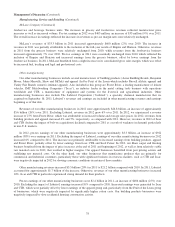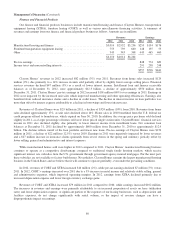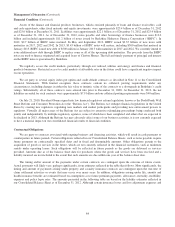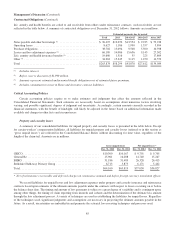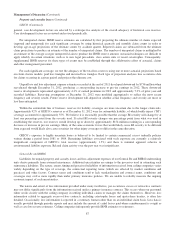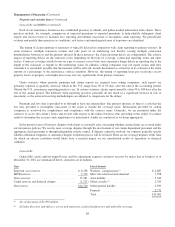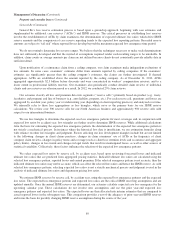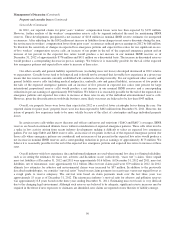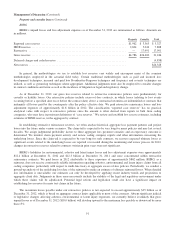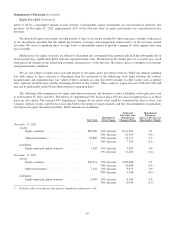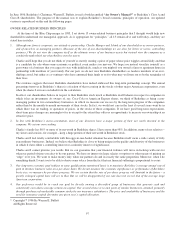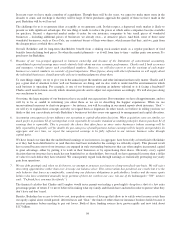Berkshire Hathaway 2012 Annual Report Download - page 90
Download and view the complete annual report
Please find page 90 of the 2012 Berkshire Hathaway annual report below. You can navigate through the pages in the report by either clicking on the pages listed below, or by using the keyword search tool below to find specific information within the annual report.
Management’s Discussion (Continued)
Property and casualty losses (Continued)
General Re and BHRG (Continued)
Each of our reinsurance businesses has established practices to identify and gather needed information from clients. These
practices include, for example, comparison of expected premiums to reported premiums to help identify delinquent client
reports and claim reviews to facilitate loss reporting and identify inaccurate or incomplete claim reporting. We periodically
evaluate and modify these practices as conditions, risk factors and unanticipated areas of exposures are identified.
The timing of claim reporting to reinsurers is typically delayed in comparison with claim reporting to primary insurers. In
some instances, multiple reinsurers assume and cede parts of an underlying risk thereby causing multiple contractual
intermediaries between us and the primary insured. In these instances, the claim reporting delays are compounded. The relative
impact of reporting delays on the reinsurer varies depending on the type of coverage, contractual reporting terms and other
factors. Contracts covering casualty losses on a per occurrence excess basis may experience longer delays in reporting due to the
length of the claim-tail as regards to the underlying claim. In addition, ceding companies may not report claims until they
conclude it is reasonably possible that the reinsurer will be affected, usually determined as a function of its estimate of the claim
amount as a percentage of the reinsurance contract retention. However, the timing of reporting large per occurrence excess
property losses or property catastrophe losses may not vary significantly from primary insurance.
Under contracts where periodic premium and claims reports are required from ceding companies, such reports are
generally required at quarterly intervals which in the U.S. range from 30 to 90 days after the end of the accounting period.
Outside the U.S., reinsurance reporting practices vary. In certain countries, clients report annually, often 90 to 180 days after the
end of the annual period. The different client reporting practices generally do not result in a significant increase in risk or
uncertainty as the actuarial reserving methodologies are adjusted to compensate for the delays.
Premium and loss data is provided to us through at least one intermediary (the primary insurer), so there is a risk that the
loss data provided is incomplete, inaccurate or the claim is outside the coverage terms. Information provided by ceding
companies is reviewed for completeness and compliance with the contract terms. Generally, we are permitted under the
contracts to access the cedant’s books and records with respect to the subject business, thus providing us the ability to conduct
audits to determine the accuracy and completeness of information. Audits are conducted as we deem appropriate.
In the normal course of business, disputes with clients occasionally arise concerning whether certain claims are covered under
our reinsurance policies. We resolve most coverage disputes through the involvement of our claims department personnel and the
appropriate client personnel or through independent outside counsel. If disputes cannot be resolved, our contracts generally specify
whether arbitration, litigation, or alternative dispute resolution process will be invoked. There are no coverage disputes at this time
for which an adverse resolution would likely have a material impact on our consolidated results of operations or financial
condition.
General Re
General Re’s gross and net unpaid losses and loss adjustment expenses and gross reserves by major line of business as of
December 31, 2012 are summarized below. Amounts are in millions.
Type Line of business
Reported case reserves ........................ $ 8,258 Workers’ compensation (1) ................... $ 2,887
IBNR reserves ............................... 7,703 Mass tort-asbestos/environmental .............. 1,598
Gross reserves ............................... 15,961 Auto liability .............................. 3,349
Ceded reserves and deferred charges ............. (1,221) Other casualty (2) ........................... 2,765
Net reserves ................................. $14,740 Other general liability ....................... 2,590
Property .................................. 2,772
Total .................................... $15,961
(1) Net of discounts of $1,990 million.
(2) Includes directors and officers, errors and omissions, medical malpractice and umbrella coverage.
88


